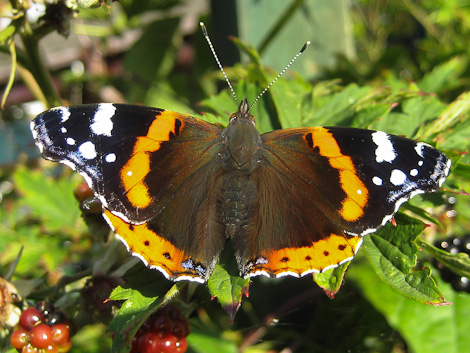When you think of migrant species, the word butterfly is not usually the first thing that pops into your head. Whilst many of us have seen pictures of the mass migrations of Monarch butterflies in America, you may not realise that many of the butterflies that we see in our gardens each year have flown in from Europe or Africa. (Although the recent coverage of the Painted Lady migrations on the fantastic Springwatch may have increased awareness of migratory butterflies.)
More surprising though is the fact that one of our commonest butterflies, the Red Admiral, is a migrant. To confuse things still further though, it is also in some cases being classed as a resident. Climate change and the warmer winters means that it is now able to survive winters as an adult in the south of the country (this includes Northamptonshire). Consequently it is often one of the first butterflies seen each year – often in January.
The Red Admiral is a striking and unmistakeable butterfly. Its Latin name is Vanessa Atalanta, named after the beautiful and athletic goddess Atalanta, a famous huntress. Atalanta tried to enlist with the argonauts but was turned down as Jason was worried about the presence of one woman on the ship. She would go to such lengths to avoid marriage that suitors were challenged to a race, those who lost, the penalty not being a sufficient deterrent, being put to death. She was eventually beaten after the love goddess Aphrodite took pity on a suitor and helped him distract Atalanta during the race.
The butterfly given her name can be seen throughout the year (although the first major migration occurs from mid-May to the end of June), in most habitats, throughout the country. It will visit many flowers, switching from one favourite to another as the summer progresses, moving onto fruit and then ivy blossom in the autumn. There would usually be a return migration in the autumn, but they are increasingly staying to overwinter in the south of England.
The food plant of the Red Admiral is the nettle, with the small, green egg laid on the upperside of a leaf. When this hatches, the caterpillar uses silk to form a tent from the leaf on which it hatched, and, as it grows it pulls in more leaves to its tent and eventually makes its chrysalis in the tent. After two and half weeks the black or yellow spiny caterpillar will emerge from its chrysalis as a stunning red, white and black butterfly.
